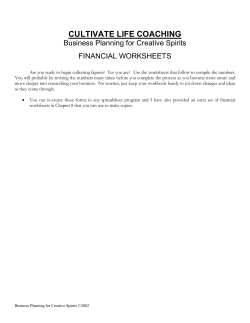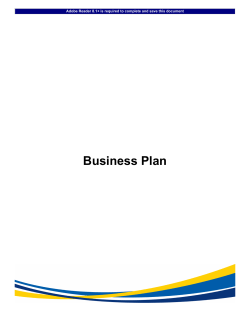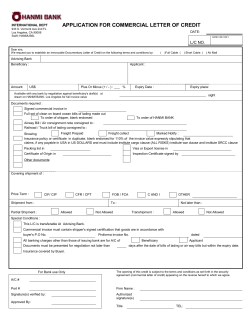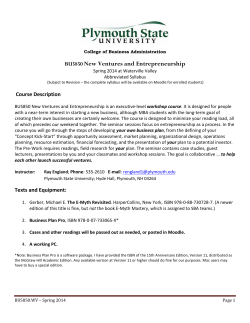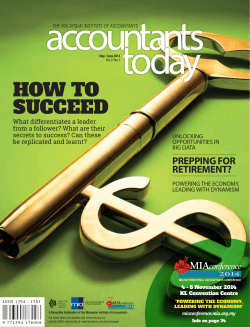
Shad Valley Business Planning Model By Barry G. Bisson MBA P.Eng. (NB)
Shad Valley Business Planning Model Financial Projections Made Simple – The Three Scorecards By Barry G. Bisson MBA P.Eng. (NB) Chapter 1.0: Introduction Throughout my career as an educator I have had the pleasure of working with many great students/entrepreneurs who were keen to learn how to transform their exciting business idea into a successful start-up venture. In most cases the students had limited, if any, knowledge and understanding of accounting and finance, yet were faced with the reality that financial projections are an essential component of a good business plan. Several years ago I concluded that probably most budding entrepreneurs face a similar challenge so I decided to develop a tool to help them. The development of the model has been a very rewarding, but seemingly never ending journey because I am constantly receiving suggestions for enhancements from users. There is more to the model than meets the eye. On first glance it is just another spreadsheet that facilitates calculations. However I promise you that the more you use it, the better you will become at understanding a business venture from a holistic point of view. A business is like a complex eco-system with many inter-connected elements. Actions taken on any one element can have positive or negative effects on other elements. Just like in nature, the challenge is to keep the complex system in balance, while it is being subjected to external forces, so that it will remain healthy and flourish, producing very positive outcomes. I named it the Shad Valley Business Planning Model because I initially developed it to help exceptional high school students with an entrepreneurship project they undertake each year in Canada’s flagship Shad Valley program (more details about this program follow). Thanks to the late Dr. Jeffry A. Timmons of Babson College who referenced my model in the 7th edition of his book New Venture Creation, it is now being used by entrepreneurship students around the globe. I also use it in an entrepreneurial finance course I teach to masters students at the University of Waterloo. The responses I have received from users have been overwhelmingly positive. Whether you are a high school student or a university grad, a business neophyte or an experienced entrepreneur, a financial expert or a person who has never had any exposure to finance, the model can help you transform a business idea into success, so give it a try. For those of you who have no background in finance and accounting I have prepared a brief and simplified introduction to financial statements (Chapter 3) because they are the foundation of my model and you need to have a basic understanding of their purpose before you use it. The rest of you can start using my model which can be found at http://www.shad.ca/shad/myweb.php?hls=10265 . Bon voyage! Chapter 2.0: About the Author Barry G. Bisson was appointed President of Shad Valley International (SVI) in January, 2005. SVI is a non-profit organization that currently operates the flagship Shad Valley Program at ten Canadian universities. Shad Valley's mission is “to provide a transformational experience that unleashes the entrepreneurial and innovative potential of exceptional youth”. Since its inception the program has challenged Canada’s highestachieving youth to realize and deliver on their full potential by developing their leadership abilities, creativity, entrepreneurial passion and other skills that are essential for success in our global knowledge-based economy. Barry has had a long history with Shad Valley. He was the first Director of the Shad Valley program at the University of New Brunswick in 1985 and 1986 and served again as Director from 1998-2004. He joined the Board of Directors of SVI in 2000. Before joining Shad, Barry was a Professor in the Faculty of Engineering at the University of New Brunswick from 1983-2004. He held the Dr. J. Herbert Smith/ACOA Chair in Technology Management and Entrepreneurship. This program was established in 1988 to address the need for business and entrepreneurship education for engineers and others with an interest and/or background in technology. Barry joined the Faculty of Engineering at UNB in 1983 as a Professor of Civil Engineering and Coordinator of the UNB Transportation Group. He served in this capacity until July 1994 when he was appointed Chair of the Technology Management and Entrepreneurship (TME) Program. Prior to joining UNB he worked for nine years in the federal public service for Transport Canada in various positions related to air transportation in Canada. He also has had considerable experience in the private sector since 1983 as a management consultant to numerous corporations and government agencies. He is an adjunct Professor in the Faculty of Engineering at the University of Waterloo and teaches a course (Entrepreneurial Finance) to graduate students in the Masters of Business Entrepreneurship Technology Program. Barry holds BSc and MSc degrees in Civil Engineering from the University of New Brunswick and an MBA from Harvard University. He is a member of the Board of Directors of Shad Valley International as well as the advisory boards of the UNB Faculty of Engineering, IMPACT, a student entrepreneurship organization and the Wallace G. McCain Institute for Business Leadership at UNB. In 2009 he was named a Fellow of Engineers Canada. He has served as a mentor to a number of young entrepreneurs. Brother for several years in Fredericton, New Brunswick. He was also a Big Chapter 3.0: Financial Statements Made Simple - The Three Scorecards Before jumping into the business planning model it is essential that users have a basic understanding of the three scorecards that entrepreneurs/managers use (in both for-profit and not-for-profit entities) to keep track of the financial well-being and outcomes of their business/organization. I am referring to what accountants call the “balance sheet”, the “income statement” and the “cash flow statement” (the latter sometimes referred to as the statement of changes in financial position). If your eyes are glazing over and you are about to stop reading because of your fear of accounting and finance or your perception that it is boring, please bear with me. I promise you that within a few minutes, your understanding of the basic information that is communicated in these three scorecards will be as good as that of the Chief Financial Officer (CFO) of a large successful corporation. I promise. So keep reading! Let us begin with the balance sheet. 3.1 The Balance Sheet As an entrepreneur all you really need to know about the balance sheet is: a) It provides a snapshot of the financial status of the business as of a given point of time (ie. the date of the end of the month or quarter or fiscal year). b) It has two sides. On the left are the “Assets” of the business. “Assets” are things of value that are owned by the business (eg. cash, inventory, vehicles, factory, equipment). The key word is owned. If your business purchased a truck for $30,000 it is recorded as an asset on the balance sheet at value of $30,000. (Note: Assets are recorded on the balance sheet at the cost paid to acquire them). If however, your business is leasing a truck, it is not owned and therefore is not an asset. You often hear a CEO say “our people are our most important assets”. Well, in an accountant’s world this is not true because, slavery is illegal in most countries so the company does not own the people, therefore they are not assets! c) On the right side of the balance sheet are the amounts of financial claims against the assets by debtors and the owners. These claims are referred to as “Liabilities” (claims of debtors) and “Equity” (claims of owners). d) “Liabilities” are amounts the business owes to debtors, such as suppliers who are letting you buy (on credit) raw materials that will be used to manufacture your product, or a bank that has given you a loan to buy a truck. The amounts your business owes are listed on the right side of the balance sheet under the heading “Liabilities”. e) “Equity” is the residual claim against the value of assets of the company by the owners after liabilities have been accounted for (the so-called “net worth” of the business). It is very similar to the “net worth” of an individual which is calculated by subtracting from the value of the assets the individual owns (eg. house, vehicles, cottage, savings, investments, etc) the amounts that are owed against those assets (credit card balances, car loans, personal line of credit balance, mortgage, etc.). f) The balance sheet has a top half and a bottom half. The top half shows “short term” assets on the left and short term liabilities on the right. The bottom half shows “long term” assets on the left and long term liabilities and equity on the right. Accountants define short term as the next twelve months and long term as beyond the next twelve months. Short term assets are assets that will be converted into cash within the next twelve months (eg. inventory that will be sold to customers). Short term liabilities are amounts owed that will be paid back within the next twelve months (eg. amounts owed to suppliers for purchasing raw materials on credit). Long term assets are assets that have an economic life in excess of one year (eg. vehicles, factory, computers, equipment). Long term liabilities are the principal amounts on loans/mortgages that will be paid back beyond the next twelve months (eg. a mortgage might be paid back over 20 years). Equity is the residual long term claim of owners against the assets of the business. Accounts assume a business will be a going concern for the long term, and of course the business must have owners. So, in summary, a balance sheet is a snapshot that shows, as of a given date, the historical cost of the things of value the company owns (“the assets”), the amounts owed against the assets (“the liabilities”) and the residual claim against the assets held by the owners (“equity”). Accountants organize the balance sheet so that you get both a short term and long term perspective on the financial status of the business. You will learn more about the balance sheet as you begin using the business planning model, but for now you have the same understanding of the basics of a balance sheet as a an experienced CFO! And is not that complicated, is it? (Note: if you are getting excited about becoming a financial expert, you might want to check out some courseware I have authored that provides a more in-depth look at the balance sheet at http://www.unb.ca/jhsc/resourcectr/TME_courses/tme3013/balance_sheet/ ). The income statement and cash flow statements are even easier to understand so don’t give up now. You are almost a CFO! 3.2 The Income Statement I lied! The income statement is based upon a complex mathematical formula. Here it is: Sales - expenses = profit. Can you handle that formula? If so, allow me to add some complexity. Unlike the balance sheet, the income statement covers a period of time, ie. the month, the quarter, the fiscal year. So accountants keep track of the sales of the period (sometimes referred to as “revenue”) and typically they record the sales when the goods or service have been delivered to the customer. For example, if you buy an airline ticket in January for a trip you will make in March, the accountant will not record/book the revenue until you have made the trip in March. Accountants also keep track of, and match against the revenue, all of the expenses that were incurred in earning the revenue such as the cost of the pilots, the flight attendants and the fuel that was needed for your flight. Assuming the sales of a period are greater than the matching expenses, an objective of all for-profit businesses, the difference between the revenue and the expenses is the profit, sometimes referred to as “income” or “earnings” or “the bottom line”. Occasionally there may be periods during which the expenses exceed the sales and in this case the accountants record what is called a “loss”. One last bit of complexity. In most countries, when a business makes a profit or income, the profit/income is taxed by governments. This is referred to as corporate income tax. So let’s modify the income statement formula. Sales – expenses = profit before tax Profit before tax – corporate income tax = profit after tax Profit after tax is often referred to as “net income” or “after tax earnings”. So there you have it, the income statement, ie. the sales of a period less the expenses incurred in earning the sales, less the taxes owed on the resulting income, yielding the profit or net income of the period. Again, you will learn more about the income statement when you start using the business planning model and if you want to drill deeper now, check out my courseware at: http://www.unb.ca/jhsc/resourcectr/TME_courses/tme3013/income_statement/ . And you thought finance was complicated. You are now two thirds of the way towards having the same understanding of the basics of financial statements as an experienced CFO! So why quit now? 3.3 The Cash Flow Statement I am sorry that I tricked you into thinking finance is simple but I have to admit that the cash flow statement is also based on a complex mathematical formula! Here it is: Cash in – Cash out = Cash Flow Now that is not so bad, is it? It’s like keeping track of the balance in your cheque book. You record all deposits to your chequing account for a given period (say one month) and keep a running total of the amounts of all cheques you have written and the difference is your cash balance or net cash flow for the month. Now that you understand that the concept of cash flow is real simple, you are probably asking yourself, “what is the difference between the cash flow statement and the income statement?” After all, income is “revenue in” minus “expenses out”. Isn’t that the same as “cash in” minus “cash out”? That would be too simple. Accountants have peculiar ways of keeping track of things. Remember the flight you book in January for a trip in March. Well you will give the airline your cash in January when you book the flight but the accountant will not recognize it as sales/revenue until you make the trip in March. But on the January cash flow statement the accountant will record your payment for the ticket as cash in. Similarly, the airline may purchase the fuel for your trip in March and record the expense on the March income statement because you took the trip in March. However they probably have an arrangement with the fuel supplier whereby the supplier invoices the airline at the end of each month for all fuel purchases during the month and allows the airline another 30 or maybe even 60 days to pay the invoice. This is a common practice in most businesses. So we have an expense that will be recorded on the March income statement, but the cash outflow will not be recorded on the cash flow statement until April or possibly May. I could give you many more examples of how the timing of recognition of sales might be different than the timing of recognition of cash inflow or how the timing of recognition of expenses might be different than the timing of recognition of cash outflow. However, hopefully you get the point. For a given period of time (say a particular month), income/profit calculated by subtracting expenses from sales can be different from cash flow calculated by subtracting cash outflows from cash inflows. When you look at a cash flow statement prepared by an accountant you may get a big scare because it will not look like your cheque book and it will certainly look different than my simplified version of “cash in” minus “cash out” equals “cash flow”. Don’t worry. Be happy! Believe it or not, accountants actually do try to be helpful to readers of financial statements by organizing all cash transactions into three groupings: 1) “cash flow from operations”. Transactions related to short term assets and liabilities the normal operations of the business such as collecting money from customers who purchased our products on credit or paying our suppliers who have given us 30 or 60 days to pay for the raw materials we have purchased. 2) “cash flow from investing activities”. Transactions related to investments made in long term assets such as vehicles, equipment, land and buildings. 3) “cash flow from financing activities”. Transactions related to arranging financing for the business such as getting a loan or a mortgage from a bank (or paying down the principal on either) or selling shares to investors. Don’t worry about some of the complicated looking stuff you will see within each of these groupings. You will learn more about the details of a cash flow statement when you start using the business planning model but if you feel you are becoming a financial guru and finance is now your passion, check out my courseware at: http://www.unb.ca/jhsc/resourcectr/TME_courses/tme3013/cashflow/ Let me end with one of the most profound pieces of advice I have ever heard regarding managing a business venture. I have had the pleasure of attending a presentation given by Dr. William A. Sahlman of the Harvard Business School (HBS). Dr. Sahlman is the Dimitri V. d'Arbeloff - Class of 1955 Professor of Business Administration at HBS. Throughout his career he has read thousands of business plans, has invested in several entrepreneurial ventures and has sat on many corporate boards. With all this experience he has concluded that success in business can be boiled down to what he refers to as the “four laws of cash flow”. Here they are: 1) Law # 1: More cash is better than less cash. 2) Law # 2: Cash sooner is better than cash later. 3) Law # 3: Less risky cash is better than more risky cash. 4) Law # 4: Never run out of cash! As silly as these four laws may seem, you will discover when you start using my business planning model that they are very important and meaningful principles.
© Copyright 2025


